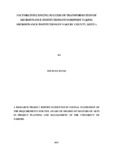| dc.description.abstract | Microfinance institutions in Kenya seek to transform mostly to deposit taking microfinance institutions with a view of accessing deposits for the purposes of lending. MFIs often seek to transform to the deposit taking MFIs as a platform to access cheap deposit funds hence further improving on their ability to lend larger loans with longer repayment period. These aspects influence their financial performance positively. Other advantages associated with transformation include improved governance structure, enhanced customer service and more products being offered to customers. Despite the advantages associated with transformation of MFIs into deposit taking MFIs, there are diverse challenges that may occur during transformation. These challenges include struggles with redefinition of identity, redrawing the boundaries of the firm and issues of legitimacy. This is due to the hybrid nature of the institutions that is the social duties of MFIs which is poverty alleviation and the commercial need to be financially self-sustaining. This study wished to examine the factors influencing the success of transformation of Micro Finance Institutions (MFIs) into deposit taking microfinance institutions in Nakuru County projects. In particular, the role of leadership, organizational culture, business reengineering, and change management practices was examined in enhancing success of the transformation of the MFIs to DTMs. This study utilized the descriptive research design. The target population of this study was the 105 staff working in Microfinance institutions which have undergone transformation in Nakuru county. A sample size of 83 respondents was used for the study andthe structured questionnaire was used for the purpose of data collection. A pilot study of this research was undertaken in Nakuru while the validity of the questionnaire was examined using experts drawn from university lecturers and industry practitioners in the field. The reliability of the questionnaire was examined using the Cronbach alpha coefficient of a threshold of 0.7 and above.The descriptive statistics that were used to better understand the responses included means, standard deviations and frequencies. The multiple linear regression was used for the study. The regression model indicated that a unit increase in leadership and change management practiceswhile other factors are held constant would result in 0.419 and 0.047 increases in success of transformation of MFIs to DTMs respectively. On the other hand, a unit increase in organizational culture and business reengineering while other factors are held constant would result in a 0.077 decrease in success of transformation of MFIs to DTMs respectively. The study was of significance to the MFI transformation managers and researchers in the feild of transformation. The study recommends that more emphasis be placed on the delegation of tasks, decisions communication levels, corporate governance framework and branding aspects for transformation to be successful. Further studies should be carried out on the influence of adoption of new technologies on the succesful transformationofMFIstoDTMs. | en_US |



